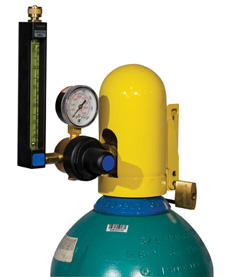



Find all of your laboratory and workplace safety supplies at Safety Emporium!
 Lachrymator |
 Glossary Index |
 LCLo |
| MSDS Topics |
Free Sites | FAQ's | Regulations | Glossary | Software | Suppliers |
| Books | Forum | Poll | Fun stuff | Quiz | Store | |
| Understand your MSDS with the MS-Demystifier | Search ALL our MSDS info | |||||

Get your GHS-compliant labels and signs from Safety Emporium.
An LC50 value is the concentration of a material in air that will kill 50% of the test subjects (animals, typically mice or rats) when administered as a single exposure (typically 1 or 4 hours). Also called the median lethal concentration and lethal concentration 50, this value gives you an idea of the relative acute toxicity of an inhalable material.
This is closely related to the LCLo value which is the lowest concentration reported to have killed animals or humans.
LC50 values apply to vapors, dusts, mists and gases. Solids and liquids use the closely related LD50 value (50% lethal dose).
Other variants that are occasionally used are the LC25 and LC75 which refer to the lethal concentration that kills 25% and 75% of test subjects, respectively. The formula for the determination of an LC50 is rather complex and can be found in 49 CFR 173.133(b)(1)(i).
Both LC50 and LD50 values state the animal used in the test. This is important because animal toxicity studies do not necessarily extrapolate (extend) to humans. For example, dioxins (of Love Canal, Times Beach, Sveso and Agent Orange fame) are highly toxic to guinea pigs and ducklings at extremely low levels, but have never been conclusively linked to a single human death even at very high levels of acute (short term) exposure. However, it is best to err on the safe side when evaluating animal toxicity studies and assume that most chemicals that are toxic to animals are toxic to humans.
Typical units for LC50 values are parts per million (ppm) of material in air, micrograms (10-6 = 0.000001 g) per liter of air and milligrams (10-3 = 0.001 g) per cubic meter of air (see volume units and mass units).
New testing regimes, such as the Acute Toxic Class (ATC) and Up Down methods, have been developed which use fewer animals and provide more reliable toxicity class assignments than the traditional LC/LD50 methods. See the links under Further Reading below.
LC50 and LD50 values, if known, will be found on Section 11 (toxicological information) of a material's Safety Data Sheet. However, the Hazard Communication Standard does not require any testing when an SDS is created, so just because this data is missing or "not known" does not mean that the material is "safe". If no toxicity information is available, treat the material as potentially hazardous!
Never be exposed to an LC50 dose of a hazardous chemical -- by definition, there is a 50% chance this will kill you...and if you survive you're not going to be in good shape.
Of greater practical use than LC50 and LD50 is the OSHA permissible exposure level (PEL) (if the material has one). This is a more realistic determination of the maximum safe exposure to a material and is usually based on the known effects of the chemical on humans rather than laboratory animals.

Safety Emporium has a great lineup of gas cylinder signs, storage racks, lockouts, clamps and more.
See also: LD50, mus (mouse), PEL, STEL, TLV.